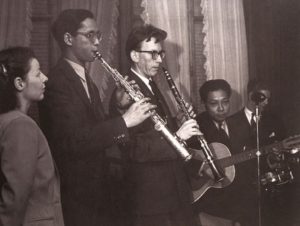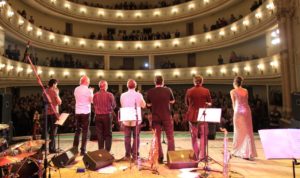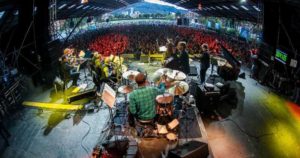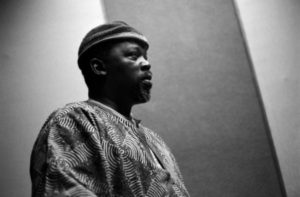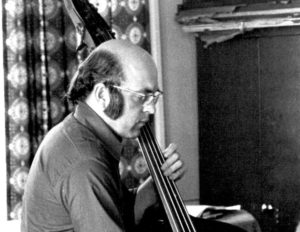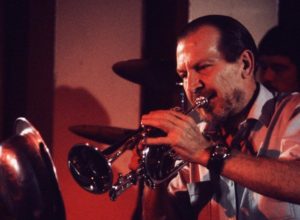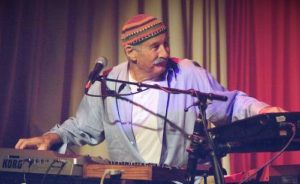Jazz in Norway
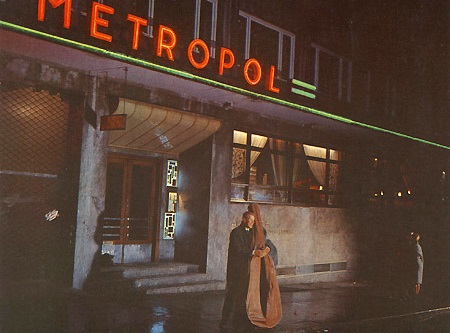
After the First World War, during which Norway remained more or less neutral, venues in the capital city Kristiana, not yet renamed Oslo, began hosting dance bands. Among the main spaces where popular music could be heard were the Grand Hotel, the Casino Theatre, and the newly built Hotel Bristol The first jazz groups to be heard in Norway, were foreign bands like the American 5 Jazzing Devils, about whose 1921 residency at the Hotel Bristol little is known, other than a shockingly unfortunate description of the band in the Dagbladet newspaper as “four negroes and a man”. The models for the first homegrown dance bands which began to appear from 1920, were white bands like the Paul Whiteman Orchestra and those of British bandleaders like Jack Hylton, and a little later Bert Ambrose.
By 1923 Norwegian dance bands included violinist Lauritz Stang‘s orchestra; the Bodø Jazz Band, a 15-piece ensemble found in the Northern town of Bodø; and the Sixpence Jazz Band, led by Ragtime pianist Fenger Grøn, whose personnel included his brothers saxophonist Sverre and drummer Ragnar. Pianist Kristian Hauger (1905-1977) led some of the country’s best jazz orchestras throught the 1920s, working as musical director at both the Casino Theatre and Hotel Bristol. In 1932, he was invited by the Norwegian Broadcasting Corporation (NRK) to form a Radio Dance Band. Although the band’s repertoire was broad, the band did make what are probably Norway’s first ‘proper’ jazz recordings.
American jazz records were more widely available by the late 1920s, and the influence of Louis Armstrong, Duke Ellington and other African American jazz musicians began to be felt. Sidney Bechet appeared at the Casino Theatre and Grand Hotel in Oslo in 1926. One Armstrong devotee was trumpeter Willie Vieth (1905-1968), who played with the Sixpence Jazz Band until it folded in 1929, and was soon leading his own band, the Kaba Orchestra. Four members of Vieth’s band – saxophonist Kalle Engstrøm (1908-1955), pianist Gunnar Sønstevold (1912-1991), saxophonist Svein Øvergaard (1912-1986) and guitarist Finn Westbye (1914-1994) – broke away in 1934 to form the Funny Boys, which became the country’s most popular jazz groups in the late 1930s, recording some pretty solid swing tracks in 1938.
Spanish-Norwegian guitarist Freddy Valier had heard Django Reinhardt’s Quintette du Hot Club de France while in Spain, and formed String Swing in 1938 in imitation of Django’s music. The band’s other members, who included violinist Arild Iversen (1920-1965) and guitarists Robert Normann (1916-1998) and Finn Westbye, were less interested in gypsy jazz, and Valier soon left. The band continued under Normann’s leadership, recording a number of 78s, which show the influence of Slim Gaillard and Charlie Shavers, as much as that of Reinhardt. Normann was an early adopter of the electric guitar, using one from 1939.
As in the rest of Europe, several ‘rhythm clubs’ came into existence in the late 1930s, where passionate jazz fans could compare notes on records from the United States. These enthusiastic audiences had the chance to hear many of their heroes in person, with Coleman Hawkins performing at the Hotel Bristol in 1935, and then in quick succession the bands of Jimmy Lunceford, Duke Ellington, Fats Waller, as well as the bands of great European artists like Django Reinhardt, Nat Gonella and Svend Asmussen.
The German army invaded Norway in April 1940 and occupied the country until 1942, when they installed a tame government, led by Vidkun Quisling, whose name has become synonymous with traitorous collaboration. Cultural restrictions meant the thriving jazz scene began to be severely hampered. Jazz clubs closed down or became secret organisations, moving into private homes, with some registering as women’s sewing clubs in order to circumvent regulations. These live performance opportunities were especially important as radio was banned.
Gonella-inspired trumpeter Rowland Greenberg, who before becoming a professional musician was a champion cyclist, had worked in London in the late 1930s with George Shearing and Vic Lewis. On his return to Oslo in 1939, he led his own bands featuring musicians like drummer Pete Brown (1921-2009), saxophonists Arvid Gram Paulsen (1922-1963) and Bjarne Nerem (1923-1991), Fred Lange-Nielsen and Robert Normann. Greenberg found himself jailed in 1943, after having a record release banned, and for the scandalous act of showing jazz films, considered by the occupying forces as anti-Nazi cultural symbols. In lieu of live work, pianist Carsten Klouman (1923-2004), Gram Paulsen, Nerem, Lange-Nielsen, and the latter’s ex-colleague from String Swing, Finn Westbye set up a recording group, Syv Muntre (the ‘Jolly Seven’) from 1942 to 1944.
In the post-war years, Norway’s jazz scene struggled to resurface as strongly as its neighbours. Sweden recovered quickly and entered a ‘golden era’ of jazz in the 1950s, not least with visits from bebop musicians like Don Byas, James Moody, Dizzy Gillespie and many other, some of whom performed and recorded with local musicians. In Norway, the years of occupation had taken their toll, and in the late 1940s and early 1950s some talented bebop players like Bjarne Nerem and drummer Egil Johansen (1934-1998), moved to Sweden. From 1952, the Big Chief Jazz Band became Norway’s leading proponent of the Dixieland revivalism that swept through Europe. The band hosted their own jazz club, which morphed into the the jazz club, which helped launch the country into its own golden age.
From around 1959-1960, the Big Chief Jazz Club began to host international jazz artists under the name, the Metropol Jazz House in 1959. Although it lasted just six years, it played host to a diverse jazz programme ranging from New Orleans clarinetist Albert Nicholas to Cecil Taylor’s trio. In a pattern seen across Europe, the opportunity to play with leading American jazz musicians helped foster a generation of players, who would then have an impact on the music in their own country. Swing pianist Einar Iversen (1930-2019), who recorded with Rowland Greenberg’s big band in 1953, got to play with Dexter Gordon and Don Byas. Pianist Kjell Karlsen (1931-2020) accompanied Stan Getz and Benny Bailey. Drummer Jon Christensen (1943-2020) was still a teenager when he played with Byas and Gordon in the Metropol house trio. The early 1960s also saw the arrival of a serious jazz magazine, Jazznytt (1960) and two important jazz festivals – Molde (1961) and Kongsberg (1964).
More to come…
